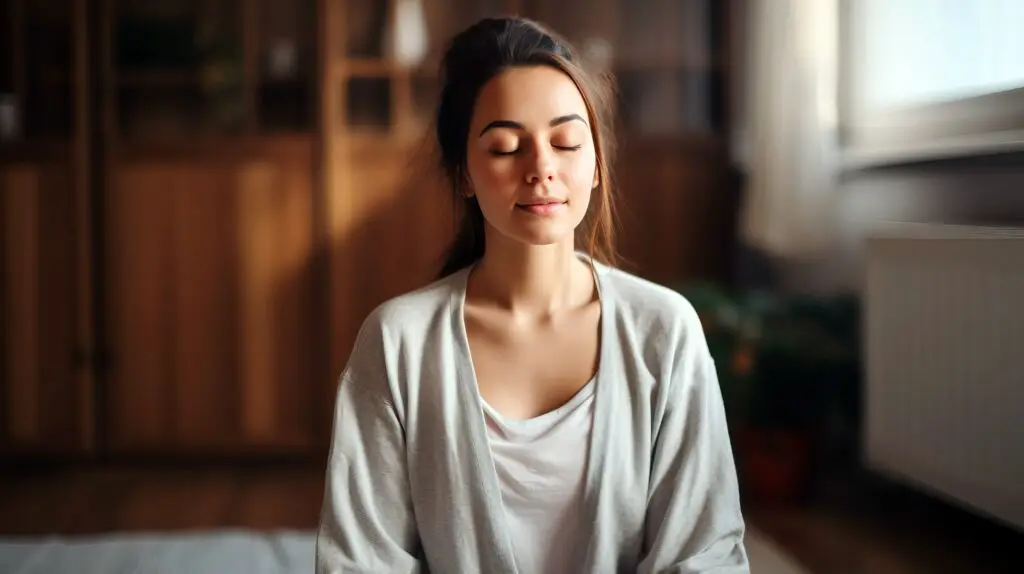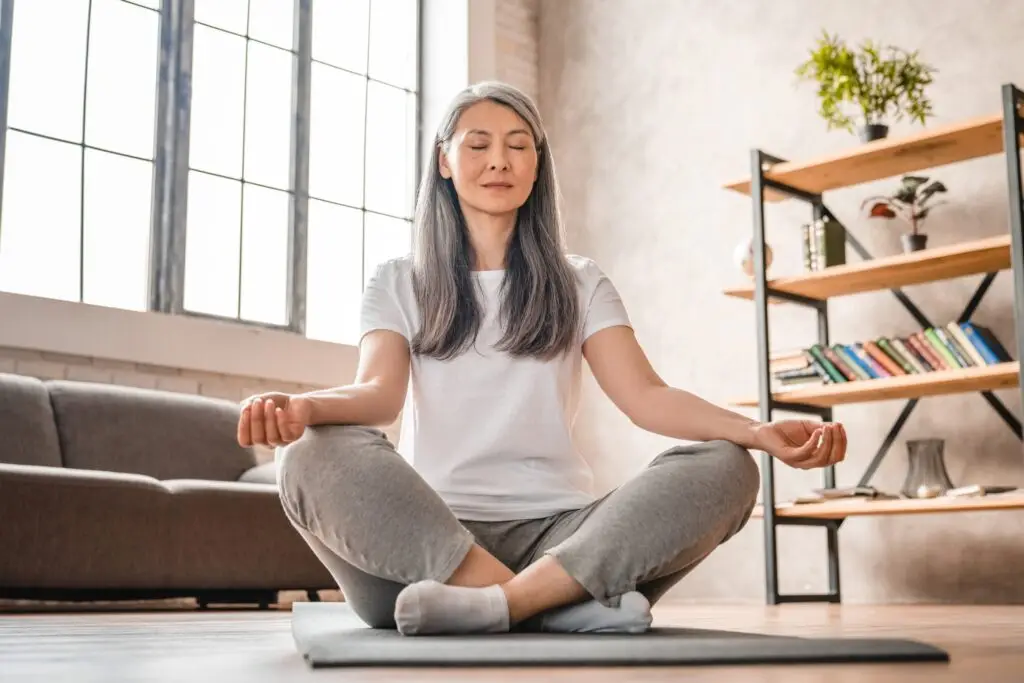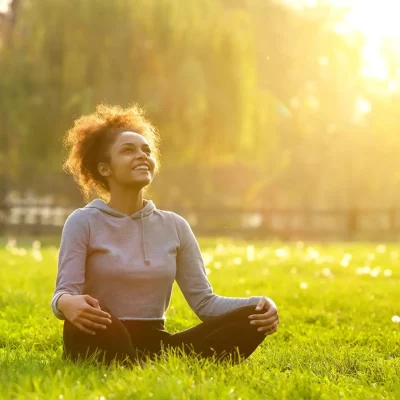Do you feel overwhelmed with anxiety?
Anxiety is a common concern that can affect you or anyone at any age. While it is a normal stress response and can even be beneficial in certain situations, when it becomes excessive and uncontrollable, anxiety can interfere with daily life. If you are struggling with anxiety, know that you are not alone. There are many ways to manage and cope with anxiety so you can live a happier and more fulfilling life.
Meditation is a practice developed over time that has a multitude of physical and mental benefits that are in line with reducing anxious triggers.
A short meditation session can lower heart rate and ease manifesting symptoms in the short term. In the long-term, a consistent meditation practice can reduce or alleviate anxious triggers by increasing your stress threshold overall and ability to sort through unhealthy thought patterns and redirect to healthy ones.
In this article, we’ll explore what meditation is, different types of meditation practices, and which types are best for reducing anxiety. So, if you’re looking for some natural relief from your anxious feelings and want to learn how to meditate for anxiety, read on.
What is meditation?
Meditation has been practiced for centuries, dating back to ancient Indian and Chinese cultures. It’s used to achieve greater mental focus, relaxation, and clarity of mind. During meditation, practitioners focus on an object, a thought, or a feeling to calm the mind. The goal is to let go of distracting thoughts and negative emotions and access a state of inner peace.
Meditation can reduce stress, anxiety, and depression as it helps clear away the mental clutter that can lead to negative feelings. Studies have shown that regular mindfulness-based meditation can help reduce cortisol levels (the body’s primary stress hormone). It also reduces activity in the amygdala – an area of the brain linked with fear and stress responses – which leads to an overall calming effect on the mind.
Additionally, regular meditation practice has been linked with improved emotional regulation and increased feelings of joy and happiness. Research shows that long-term participants show increased levels of oxytocin – a hormone associated with bonding, trust, and connection – which leads to better relationships with others.
Overall, meditation is beneficial for managing stress, anxiety, and depression while promoting peace, happiness, and emotional health.

Different types of meditation practices
Several types of meditation practices can be used to reduce anxious feelings and promote peace and calmness. This list includes four of the best meditation techniques used to relieve anxiety.
1. Mindfulness meditation
This approach involves paying attention to the present moment without judgment or expectations. Mindfulness allows you to recognize your thoughts and feelings without getting caught up. Studies show regular mindfulness meditation can improve mental well-being, increase stress resilience, improve emotional regulation, and decrease anxiety.
2. Loving-kindness or metta meditation
Loving-kindness meditation involves repeating positive affirmations such as “May I be happy” or “May I be free from suffering” while focusing on a feeling of kindness towards oneself or others. This practice has increased self-compassion, reduced anger and fear, improved social relationships, and decreased stress levels overall.
3. Positive visualization
During a positive visualization practice, you focus on specific images or scenarios that bring calmness and relaxation while allowing distracting thoughts to drift away. Studies have shown visualization techniques can help reduce symptoms associated with mood disorders like depression, anxiety, and PTSD by calming the mind and body so it can return to a state of equilibrium.
4. Breath awareness
The breath awareness technique of meditation helps to reduce anxious feelings by allowing you to focus more deeply on the present moment while calming the mind and body through controlled breathing exercises. The goal here is not necessarily deep breathing (although this can be beneficial). The focus is to develop an awareness of your breath – noticing how it feels when you inhale and exhale deeply – which can help reduce stress levels by bringing your attention back to the present moment.
Try using one of these two inhaling/exhaling patterns for your breath awareness practice:
- a 4-second inhale, and a 4-second exhale
- a slow 10-second inhale with a hold of 4 seconds, then a slow 10-second exhale.
Each can offer help in different ways. You and your Makin Wellness therapist can work together to help determine which breathing exercises work best for your needs.
Overall, meditation practices provide powerful tools for reducing anxiety and depression levels naturally without relying solely on medication or therapy alone. Combining different methods – mindfulness meditation, loving-kindness/metta meditation, visualization techniques, or breath awareness –allows us greater relaxation and inner peace even in distress.

How to start a meditation practice
Starting a meditation practice can be a simple process that can lead to deep relaxation, improved mental health, and emotional balance. Here are some tips on how to begin your journey with meditation for anxiety now:
Choose the right time:
The best time to incorporate meditation into your daily life is when you feel most relaxed and in tune with yourself. This could be first thing in the morning or during a break at work – whatever works best for you.
Set aside time:
Start small by dedicating just 10-15 minutes of your day to meditation. Even such short amounts of time can have huge benefits and allow you to develop greater focus and clarity over time.
Choose a comfortable spot:
Make sure you have a space that is quiet and free from distractions so that you can focus on the present moment without being interrupted or pulled away by outside noises or activities.
Practice regularly:
Consistency is crucial, so try to make it a habit by practicing meditation every day for 10-15 minutes. This will help build consistency in your practice, leading to longer sessions of uninterrupted mediation over time.
Use online resources:
Lastly, guided breathing exercises or meditation sessions are highly accessible on any device with an internet connection. Many free resources, like the CALM app, can be found on YouTube or Google, as well as paid ones.
If you’re looking for something more straightforward than the options above, you can play nature sounds or meditation music, set a timer, and create a calm space to practice these techniques.
No matter your budget, there are options to help you make meditation a part of your daily routine.
An example schedule could look something like this:
- Wake up 10 minutes earlier than usual each morning, make yourself some tea or coffee (or whatever beverage you enjoy), and find a comfortable spot indoors or outdoors where you won’t be disturbed for the next 15 minutes (make sure to turn off all devices!).
- Once settled in, take a few deep breaths before beginning your meditation practice, such as mindfulness techniques or loving-kindness/Metta Meditation. Feel free to add music if desired. After completing your session, take another few moments to sit quietly before getting up slowly and mindfully transitioning back into your daily routine.
Taking 10-15 minutes out of your busy schedule each day for your new dedicated meditation practice can drastically reduce stress levels while increasing your capacity for joy and happiness. With consistent effort and dedication, you can benefit from developing your meditation practice – no matter your experience level.
How to get help for your anxiety symptoms
If anxiety affects your ability to complete daily tasks or work, seeking help from a online Makin Wellness counselor specializing in anxiety therapy can be essential for managing your stress and learning coping skills that get you back to functioning well throughout your day.
The therapeutic relationship between you and your online therapist is one of the most essential parts of therapy. Therapists provide an empathetic, non-judgmental space to talk openly about your experiences with anxiety. They are knowledgeable professionals who will listen to your concerns and provide evidence-based therapies that can help you manage your symptoms better.
Different online therapy options for anxiety include:
- cognitive behavior therapy (CBT)
- dialectical behavior therapy (DBT)
- EDMR if the anxiety is rooted in trauma
- family therapy
- art therapy
Therapists understand the complexity of mental health conditions like anxiety and have expertise in identifying associated triggers or patterns. They can also recommend helpful strategies, such as specific relaxation exercises or breathing techniques, like meditation, that may be beneficial for managing anxious thoughts or feelings.
Overall, a professional therapist is essential for gaining insight into yourself and developing a better understanding of how anxiety affects your daily life while guiding coping effectively with it. With their support and expertise, you can start taking small steps towards reducing anxiety levels while leading a happier, healthier life.

Conclusion
Anxiety is a common condition affected by millions of Americans that can manifest in your daily thoughts and actions. Leaving your symptoms unmanaged may hinder your ability to perform daily tasks or advance in your career because your stress level leaves little room to focus on anything else.
Meditation is a tool to keep in your coping and grounding skills arsenal to help calm your over-stressed system to reduce anxiety levels and increase peacefulness. In learning about the different meditation techniques in this post, you can begin your meditation journey to find a deep sense of calm and the ability to navigate stress in your life.
If you are ready to manage your anxiety symptoms and start reaching your goals, call us at (833)-274-heal or start here to make an appointment with a specialized anxiety counselor. Today is the start of prioritizing a more peaceful life.








